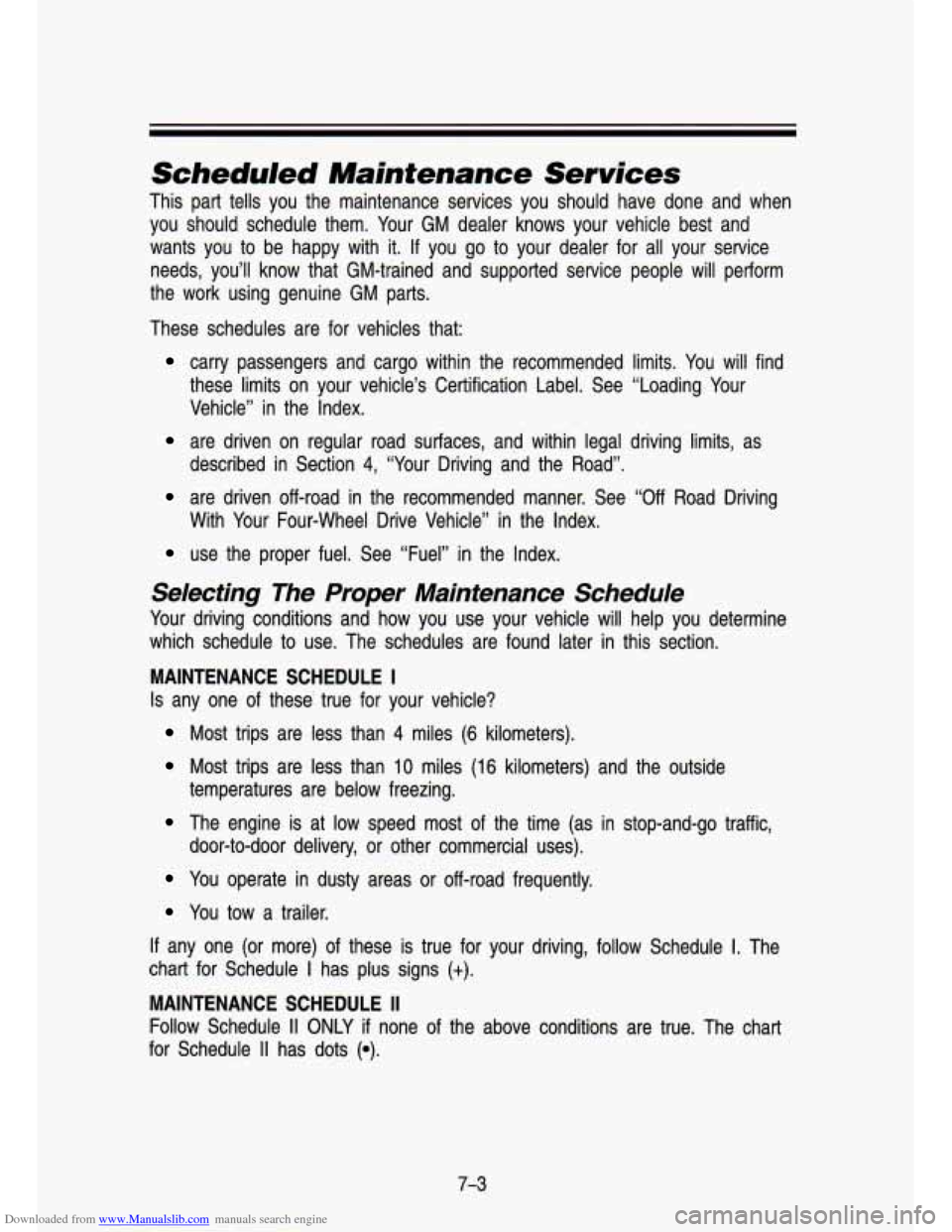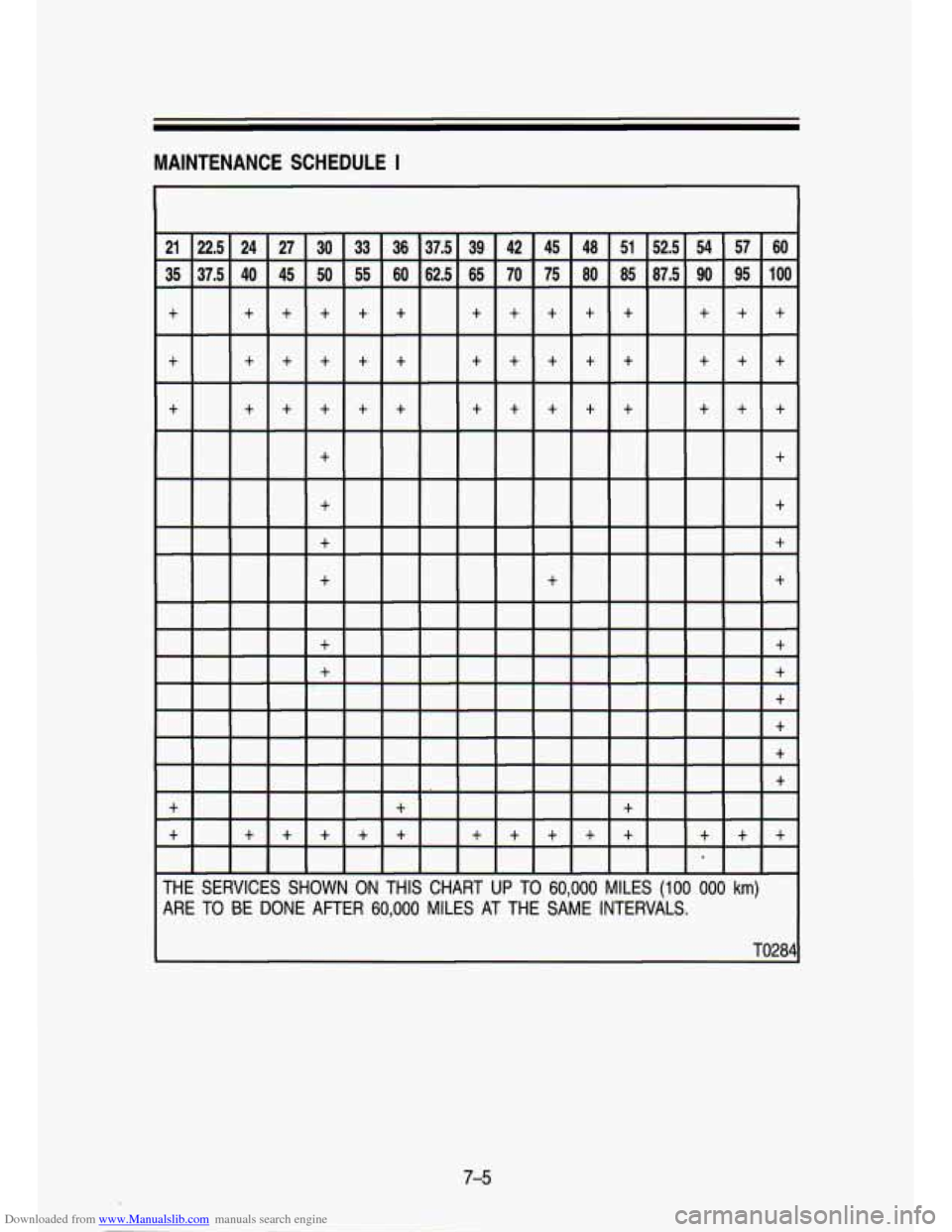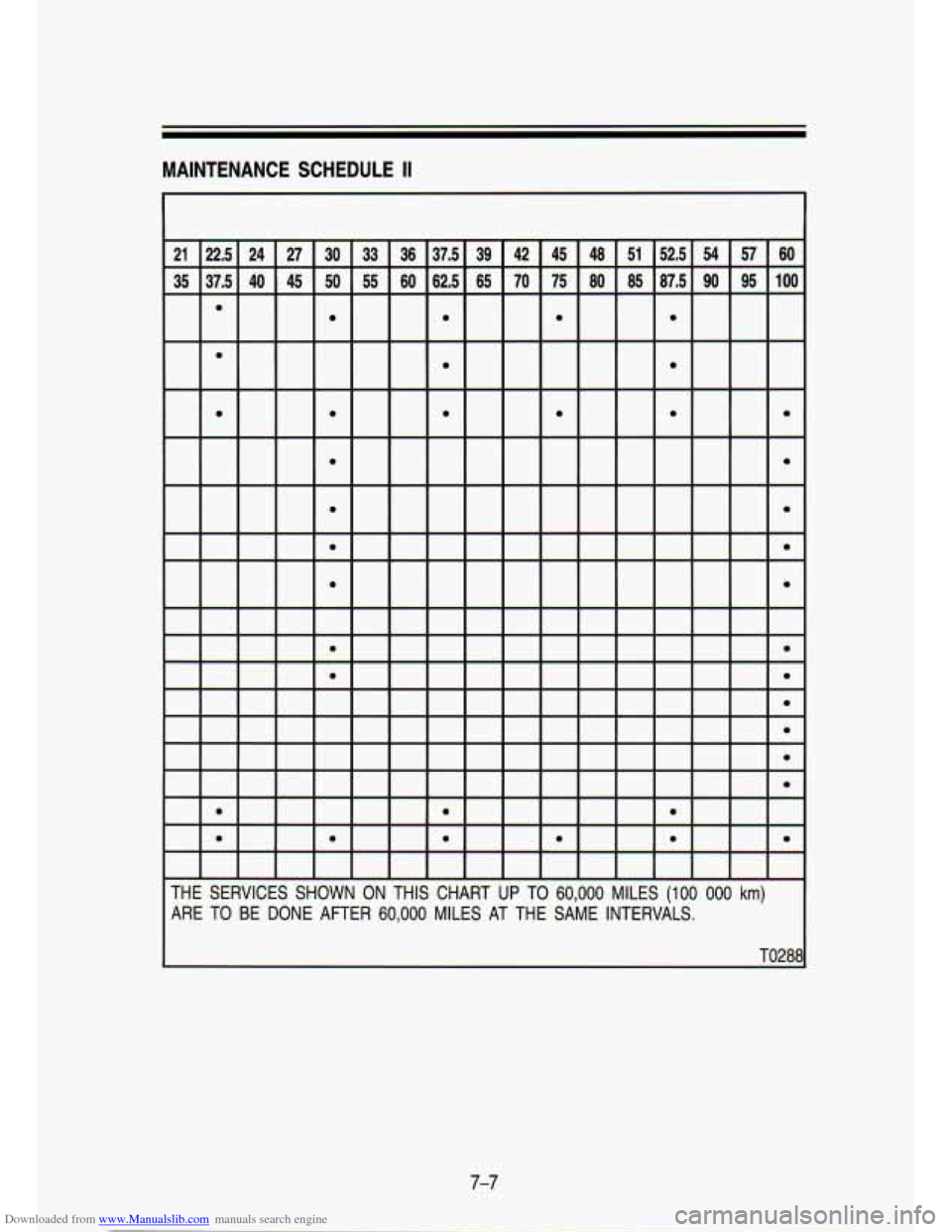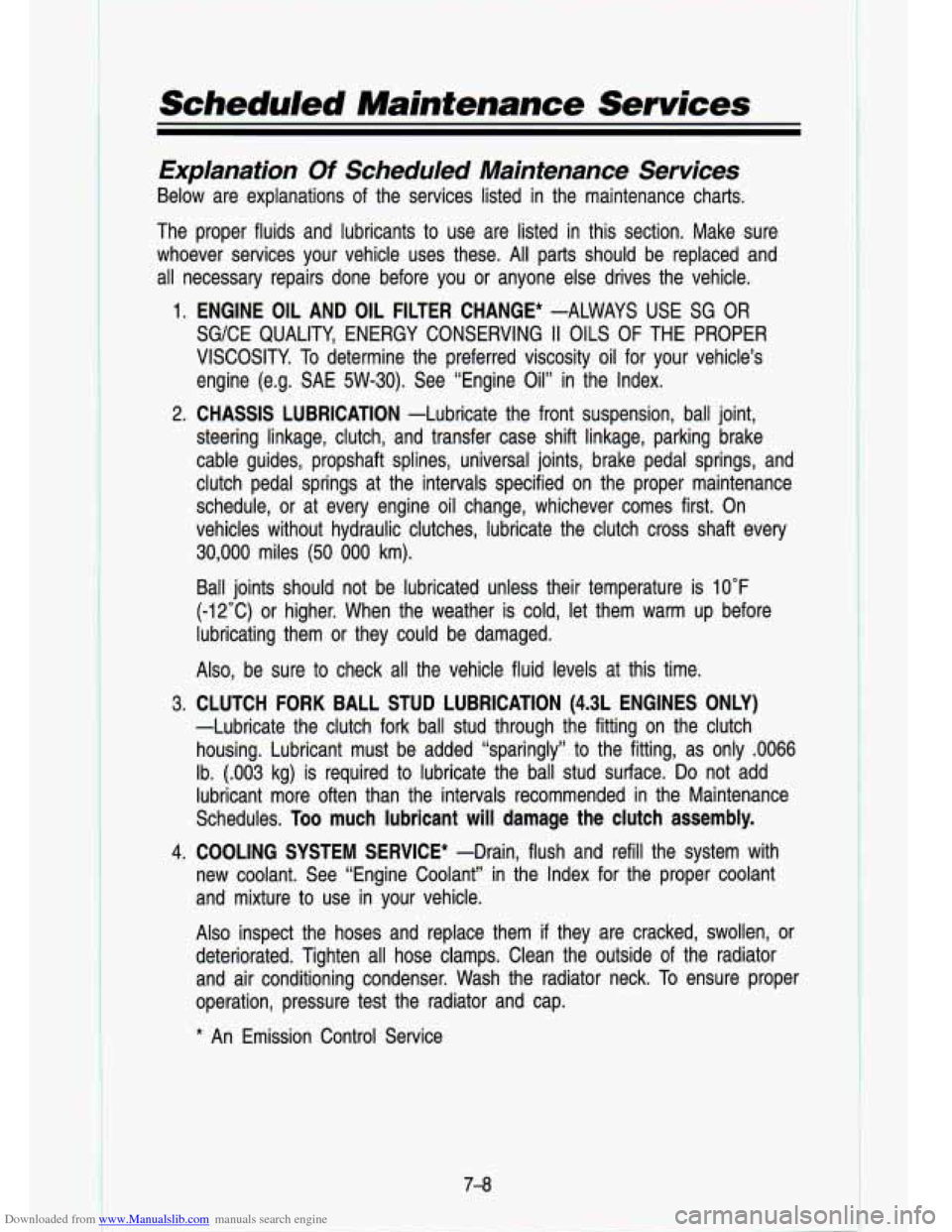1993 CHEVROLET S10 service
[x] Cancel search: servicePage 319 of 356

Downloaded from www.Manualslib.com manuals search engine Scheduled Maintenance Services
This part tells you the maintenance services you should have d\
one ana when
you should schedule them. Your
GM dealer knows your vehicle best and
wants you to be happy with
it. If you go to your dealer for all your service
needs, you’ll know that GM-trained and supported service peop\
le will perform
the work using genuine GM parts.
These schedules are for vehicles that:
carry passengers and cargo within the recommended limits. You will find
these limits on your vehicle’s Certification Label. See “L\
oading Your
Vehicle’’ in the Index.
are driven on regular road surfaces, and within legal driving \
limits, as
are driven off-road in the recommended manner. See “Off Road Driving
use the proper fuel. See “Fuel” in the Index.
described in Section
4, “Your
Driving and the Road”.
With Your Four-wheel Drive Vehicle” in the Index.
Selecting The Proper Maintenant- ~ Schedule
Your driving conditions and how you use your vehicle will help you \
determine
which schedule to use. The schedules are found later in this section.
MAINTENANCE SCHEDULE
I
Is any one of these’ true for your vehicle?
Most trips are less than 4 miles (6 kilometers).
Most trips are less than 10 miles (16 kilometers) and the outside
The engine is at low speed most of the time (as in stop-and-go traffic,
temperatures are below freezing.
door-to-door delivery, or other commercial uses).
You
operate in dusty areas or off-road frequently.
You tow a trailer.
If any one (or more) of these is true for your driving, follow Schedule I. The
chart for Schedule
I has plus signs (t).
MAINTENANCE SCHEDULE II
Follow Schedule II ONLY if none of the above conditions are true. The chart
for Schedule
II has dots (e).
7-3
Page 320 of 356

Downloaded from www.Manualslib.com manuals search engine Scheduled Maintenance Services
SCHEDULED MAINTENANCE SERVICES FOR
I
If your driving conditions meet those specified i
Services” in this Section (or see Index), use
M
Item I I Miles (000) I 3 I 6
No. Service Kilometers (000) 5 10
1 Engine Oil Change*
I -Even/ 3 Months, or
Oil Filter Change*
-Every 3 Months, or
tt
2 Chassis Lubrication-Every 12 Months,
,, Clutch Fork Ball Stud Lubrication (4.3L or J I engines only) I
4 Cooling System Service*-Every 24
1 Months or
5 I Air Cleaner Filter Replacement* I I
6 Front Wheel Bearing Repack (2WD
Only)
7 Transmission Service**
8 Fuel Filter Replacement*
9 Spark Plugs Replacement*
10 Spark Plug Wire Inspection*
11 Engine Timing Check*
12 Fuel Tank, Cap and Lines Inspection*
13 Engine Accessory Drive Belt Inspection*
14 Tire and Wheel Rotation
t
15 Drive Axle Service tt
16 Brake Systems Inspection**
FOOTNOTES:
*An Emission Control Service
**See “Explanation
of Scheduled Maintenapce Services” i n the Index
TO283
7-4
Page 321 of 356

Downloaded from www.Manualslib.com manuals search engine MAINTENANCE SCHEDULE I
THE SERVICES SHOWN ON THIS CHART UP TO 60,000 MILES (100 000 km)
ARE TO BE DONE AFTER 60,000 MILES AT THE SAME INTERVALS.
T028r
7-5
Page 322 of 356

Downloaded from www.Manualslib.com manuals search engine scheduled Maintenance Services
I
SCHEDU--D MAIM 4ANCE SEf -7s FOR
If your driving conditions meet those I
Services” in this Section (or see lnde
Item Miles
(000)
No. Service Kilometers (000)
1 Engine Oil Change*
Oil Filter Change* -Every 12 Months,
or
-Every
12 Months, or
2 Chassis Lubrication-Every 12 Months, or
Clutch Fork Ball Stud Lubrication (4.3L
engines only)
Months or
3
4 Cooling System Service*-Every 24
5 Air Cleaner Filter Replacement*
6 Front Wheel Bearing Repack (2WD
7 Transmission Service**
8 Fuel Filter Replacement*
9 Spark Plugs Replacement*
10 Spark Plug Wire Inspection* 11 Engine Timing Check*
12 Fuel Tank, Cap and Lines Inspection*
13 Engine Accessory Drive Belt Inspection*
14 Tire and Wheel Rotation
15 Drive Axle Service
16 Brake Systems Inspection**
Only)
FOOTNOTES:
*An Emission Control Service
36
5 10
**See “Explanation of Scheduled Maintenance Services” in the Index
TO287
7-6
Page 323 of 356

Downloaded from www.Manualslib.com manuals search engine MAINTENANCE SCHEDULE II
21
35 22.5
37,5
0
0
0
0
0
36
60 37.5
62.5
0
0
0
0
0
-
39
65 -
-
THE SERVICES SHOWN ON THIS CHART UP TO 60,000 MILES (100 000 km)
ARE TO BE DONE AFTER 60,000 MILES AT THE SAME INTERVALS.
T028t
7-7
Page 324 of 356

Downloaded from www.Manualslib.com manuals search engine Scheduled Maintenance Services
Explanation Of Scheduled Maintenance Services
Below are explanations of the services listed in the maintenance charts.
The proper fluids and lubricants to use are listed in this se\
ction. Make sure whoever services your vehicle uses these. All parts should be \
replaced and all necessary repairs done before you or anyone else drives th\
e vehicle.
1. ENGINE OIL AND OIL FILTER CHANGE* -ALWAYS USE SG OR SG/CE QUALITY, ENERGY CONSERVING
II OILS OF THE PROPER
VISCOSITY. To determine the preferred viscosity oil for your vehicle’s
engine (e.g. SAE 5W-30). See “Engine Oil” in the Index.\
2. CHASSIS LUBRICATION -Lubricate the front suspension, ball joint,
steering linkage, clutch, and transfer case shift linkage, parki\
ng brake
cable guides, propshaft splines, universal joints, brake pedal s\
prings, and
clutch pedal springs at the intervals specified on the proper \
maintenance
schedule, or at every engine oil change, whichever comes first.\
On
vehicles without hydraulic clutches, lubricate the clutch cross \
shaft every
30,000 miles
(50 000 km).
Ball joints should not be lubricated unless their temperature i\
s 10°F
(-12°C) or higher. When the weather is cold, let them war\
m up before
lubricating them or they could be damaged.
Also, be sure to check all the vehicle fluid levels at this \
time.
3. CLUTCH FORK BALL STUD LUBRICATION (4.3L ENGINES ONLY)
-Lubricate the clutch fork ball stud through the fitting on th\
e clutch housing. Lubricant must be added “sparingly” to the fittin\
g, as only
.0066
Ib. (.003 kg) is required to lubricate the ball stud surface\
. Do not add
lubricant more often than the intervals recommended in the Main\
tenance
Schedules. Too much lubricant
will damage the clutch assembly.
4. COOLING SYSTEM SERVICE* -Drain, flush and refill the system wit\
h
new coolant. See “Engine Coolant’’ in the Index for th\
e proper coolant
and mixture to use in your vehicle.
Also inspect the hoses and replace them
if they are cracked, swollen, or
deteriorated. Tighten all hose clamps. Clean the outside of the radiator
and air conditioning condenser. Wash the radiator neck. To ensure proper
operation, pressure test the radiator and cap.
* An Emission Control Service
7-8
Page 325 of 356

Downloaded from www.Manualslib.com manuals search engine 5. AIR CLEANER FILTER REPLACEMENT* -Replace at specified
intervals. Ask your dealer for the proper replacement intervals for your
driving conditions.
6. FRONT WHEEL BEARING REP1 -;< (2-WHEEL DRIVE ONLY) -Clean
and repack the front wheel bearings at each brake relining, or at the
specified interval, whichever comes first.
7. TRANSMISSION SERVICE:
Automatic Transmission -Change the transmission fluid and filter \
every 15,000 miles (25
000 km) if the vehicle is mainly driven under one or
more of these conditions:
In heavy city traffic.
Where the outside temperature regularly reaches 90°F (32°C) or
In hilly or mountainous terrain.
Frequent trailer pulling.
higher.
0 Uses such as taxi, police, delivery or other commercial service\
.
If the vehicle is not used mainly under any
of these conditions, change
the fluid and filter every 30,000 miles
(50 000 km). See “Automatic
Transmission Fluid” in the Index for more information.
Manual Transmission -Transmission fluid does not require periodic\
changing.
8. FUEL FILTER REPLACEMENT* -Replace the fuel filter at the specified
9. SPARK PLUGS REPLACEMENT* -Replace spark plugs with the type
interval
or sooner
if clogged.
listed in Section
6. See “Specification Charts” in the Index.
10. SPARK PLUG WIRE INSPECTION* -Clean wires and inspect for b\
urns, cracks or other damage. Check the wire boot fit at the distributor and \
at
the spark plugs. Replace wires as needed.
11. ENGINE TIMING CHECK AND DISTRIBUTOR CHECK* -Adjust timing to underhood label specifications. Inspect the inside and outsid\
e of the
distributor cap and rotor for cracks, carbon tracking and corro\
sion. Clean or replace as needed.
12. FUEL TANK, CAP AND LINES INSPECTION* -Inspect the fuel tan\
k, cap and lines for damage or leaks. Remove fuel cap, inspect g\
asket for
an even filler neck imprint, and any damage. Replace parts as \
needed.
* An Emission Control Service
7-9
Page 326 of 356

Downloaded from www.Manualslib.com manuals search engine Scheduled Maintenance Services
13. ENGINE ACCESSORY DRIVE BELT INSPECTION*-Inspect belt. Look
for cracks, fraying, wear, and proper tension. Adjust or replac\
e as needed.
14. TIRE AND WHEEL ROTATION AND INSPECTION -For proper wear and maximum tire life, rotate tires at the first
6,000 miles (10 000
kilometers) for Schedule I or 7,500 miles (12 500 kilometers) for
Schedule
II and then every 15,000 miles (25 000 kilometers) thereafter.
Follow the instructions and patterns shown in Section
6. Check tires for
uneven wear or damage.
If irregular or premature wear is apparent,
check wheel alignment. Also, check for damaged wheels. See “\
Tires” in
the Index for more information.
15. DRIVE AXLE SERVICE -Check rear/front axle fluid level and add \
as
needed. Check constant velocity joints and axle seals for leaki\
ng.
Locking differential -Drain fluid at first oil change and refill. Check
fluid level and add as needed at subsequent oil changes. In d\
usty areas
or trailer towing applications, drain fluid at every 15,000 miles
(24
135 kilometers) and refi1l.t
Standard differential -Check fluid level and add as needed at
every oil change. In dusty areas or trailer towing applications\
, drain
fluid every
15,000 miles (24 135 kilometers) and refil1.t
More frequent lubrication may be required for off-road use.
16. BRAKE SYSTEM INSPECTION -When the engine oil is changed,
inspect the lines and hoses for proper hookup, binding, leaks, \
cracks,
chafing, etc. Check the parking brake adjustment, and the fluid\
level in
the master cylinder. A low fluid level can indicate worn disc \
brake pads
which may need to be serviced.t
When the wheels are removed for rotation, inspect disc brake p\
ads for
wear and rotors for surface condition. Also inspect drum brake \
linings for
wear and cracks. Inspect other brake parts, including drums, wh\
eel cylinders, parking brake, etc., at the same time.
Inspect brakes more often if driving habits or conditions resul\
t
in
frequent braking.
tA fluid
loss in these systems may indicate a problem. Have them inspected
and repaired at once.
7-1 0